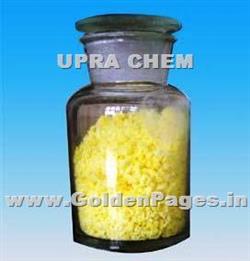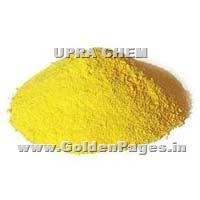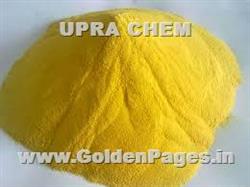UPRA CHEM P.LTD.
Featured Products
Highest quality standards are achieved through the implementations of latest technology, decades of experience and everlasting moral values , which have helped us to retain our customers as well as multiply them.
Welcome to UPRA CHEM P.LTD.
Anhydrous Aluminium Chloride

Anhydrous Aluminium Chloride:
Anhydrous Aluminium Chloride is a versatile Inorganic Chemical and finds application in a large number of Organic and Inorganic Chemical Syntheses and Reactions.
It is mainly used as Catalyst for the Chemical, Petrochemical and Pharmaceutical industries as also an auxiliary in the production of dyes and in the paper and textile industries.
Description :
Nature: Pale/golden yellow or grey crystalline substance. Very hygroscopic.
Trade name: Anhydrous Aluminium chloride, Aluminium Chloride, aluminium trichloride
Formula: AlCl3
Molar mass: 133.34 g/mol
CAS No.: 7446-70-0
EINECS No.: 231-208-1
SPECIFICATION:
Assay-Purity AlCl3 % : Minimum 99+ %
Water Insolubles % : Maximum 0.05 %
Non-Volatiles % : Maximum 0.90 %
Free Aluminium ppm : Maximum 50
Iron ppm : Maximum 150
Zinc ppm : Maximum 25
Copper ppm : Maximum 25
Lead ppm : Maximum 10
Cadmium ppm : Maximum 5
Potassium ppm : Maximum 10
(Slight variation may occur between the different grades)
Particle Size - Grade I : < 2 mm
Grade II : 2 mm to 9 mm
Grade III : 9 mm to 20 mm
Grade IV : 20 mm and above
Grade V : Mixed Grade
Properties
Reacts with moisture in the air or water to form hydrogen chloride, which has a pungent odour. Dissolves in alcohols, ethers, esters, and many other polar, organic solvents.
In some cases, adducts are formed.
Solubility in water (20 °C) 450 g/l
Melting point (2.33 bar) 192.5 °C
Sublimation point (1.1325 mbar) 181.2 °C
Bulk density approx. 1200 kg/m3
pH-value (100 g/l, 20 °C) 2.4
Application
In the chemical, petrochemical and pharmaceutical industries:
As a catalyst or as a component of catalyst systems for a number of chemical reactions, examples of which are as follows:
Reactions of aromatic hydrocarbons with alkyl halides and other halocarbons, alkenes, primary and secondary alcohols, various alkanes, carbonyl halides and anhydrides, carbon monoxide and hydrogen chloride, epoxides, unsaturated amines.
Reactions between unsaturated compounds, e.g. alkenes with hydrogen sulphide, isoalkanes, alkyl halides, acid chlorides, and (methyl) acrylates, butadiene and butadiene derivatives with formaldehyde, alpha, beta-unsaturated carbonyl compounds with vinyl ethers, alpha, beta-unsaturated aldehydes with alcohols or acetic acid.
The isomerization of alkanes and alkenes, alkyl-substituted aromatic compounds, alkyl and aryl halides.
Disproportion and transalkylation of alkyl-substituted aromatic hydrocarbons.
Disproportion of halocarbons.
Dimerization and polymerization of alkenes.
Chlorination of chloroalkanes, chloroalkenes, and other aliphatic or aromatic compounds.
Additive in the production of titanium dioxide pigments from titanium tetrachloride.
Raw material for the production of special aluminium oxides .
Auxiliary in the synthesis of dyes .
The paper industry uses it in the production of parchment ; and the textile industry for carbonizing wool .
Storage
Aluminium chloride anhydrous must be stored in a cool, dry place. Before the drums are opened, they must be aired through the lids and tightly closed again. Unopened, original containers may be stored for 12 months. If the storage period is longer, caking can be expected.
Leakages of the bundles cause an increase of pressure by reaction of aluminium chloride with air humidity to toxic and corrosive hydrogen chloride. Therefore the bundles have to be controlled in regular intervals, formed positive pressure that has to be discharged by careful opening of the vent screw. During this operation the personal protection equipment, especially respiratory protection, is to be used (for further information, please have a look to the safety data sheet).
Aluminium chloride does not burn, but it should not be stored together with combustible materials, so that the possibility of a reaction between water and aluminium chloride is excluded when extinguishing a fire.
Packaging/Delivery
The product can be supplied in the following forms:
-
ground
-
sieved
Can be delivered as follows:
-
Silsack Bag with PVC Liner
-
MS Drums
-
Jumbo Bag General-purpose packaging 250 kg and 50 kg net weight.
-
Customers containers or as requirement of customer's
The product is packed in Silsack bags under vacuum condition. This is followed by Nitrogen blanketing and finally the bags are sealed.
The standard packing is in “UN approved” mild steel drums with or without PVC liners. Packing Bulk Bags of 400 or 600 kg or 1 Metric Ton is also available.
Customized packaging can also be provided to meet individual needs.
Our Vision
* To embrace new technologies and methods. * To give unsurpassed products and services to the clients. * To constantly look for improvement and changes.




 Data For Anhydrous Aluminium Chlorode 19271.jpg)



